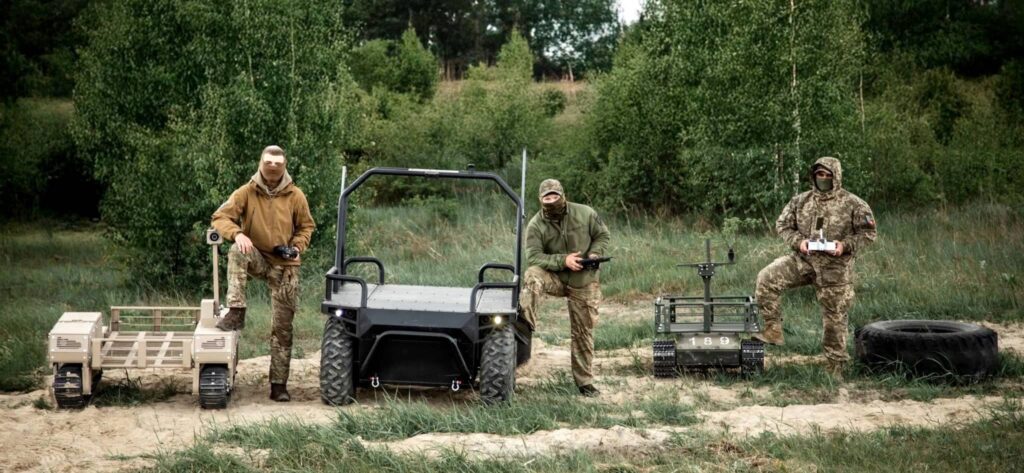Core Takeaways
- Unmanned Ground Vehicles remain difficult to design and operate in battlefield conditions compared to aerial drone systems, yet Ukraine’s developers and frontline units have brought UGVs into operational service, enhancing battlefield effectiveness and helping save soldiers’ lives.
- Logistics and wounded evacuation dominate frontline UGVs application, while combat functions remain limited but demonstrate rising potential.
- Ukraine has rapidly scaled UGV development, with most platforms now produced domestically and iterated in close cooperation between combatants and developers.
- Volunteer networks and nonprofits are instrumental in driving ground drone adoption by financing, training, and leading field experimentation.

Unmanned Ground Vehicles Landscape
Since 2023, Ukraine has turned unmanned ground vehicles (UGVs), also known as ground drones, from prototypes into practical battlefield tools. They are now used for tasks such as evacuation, resupply, and mine clearance, with modular designs also carrying communications relays, electronic warfare payloads, or weapons. Yet UGVs remain harder to design, sustain, and integrate than aerial systems, requiring stronger logistics and maintenance support.
In practice, logistics and medical evacuation dominate UGV operations. A Ukrainian officer overseeing ground unmanned systems development at Land Forces Command of the Armed Forces of Ukraine noted that 22 combat units were using them, with half of the ground drone missions focused on supply and evacuation, and only a fraction involved in combat. Units are integrating UGV systems into their operations by adjusting deployment patterns to counter russian surveillance, including reducing exposure during hours of intense aerial reconnaissance.
On the frontlines, adaptation is highly pragmatic: soldiers quickly incorporate drones into supply runs, casualty evacuation, and other routine tasks, with adjustments tested and refined under fire. Rapid training is conducted both at civil society-led centers across the country and directly on the frontlines. Innovators frequently work alongside operators, sometimes embedded within combat units, to improve systems under battlefield conditions. Some units maintain their own UGV specialists who act as mechanics, responsible for repair, adaptation, and field-driven innovation.

Experiments with artificial intelligence remain limited, but wider adoption and data collection are expected to bring gradual improvements. The priority is autonomous navigation in contested environments where communication links are disrupted or jamming is present. Advances in autonomy, hardware, and communications will allow UGVs to assume higher-risk tasks, preserving both personnel and equipment. This requires not only technical progress but also robust training, maintenance, scaled production, and doctrine for effective battlefield integration.
Dignitas, a Ukrainian nonprofit that pioneered UAV adoption through its Victory Drones initiative, is an active advocate of ground robotics adoption in the Ukrainian army through Victory Robots. The initiative funds training centers, supporting domestic developers, and supplying UGVs to units to train new recruits. Together with its partners, Dignitas Ukraine envisions UGVs taking on the most dangerous missions, and cooperation among military units, innovators, civil society, and government is steadily building the ecosystem needed to make this vision a reality.
UGVs Frontline Applications
UGVs are increasingly used for logistics, delivering supplies to forward positions and reducing the need for troops to drive vehicles into contested areas or for aerial units to risk large, costly drones such as the “Baba Yaga.” One brigade commander noted that before adopting UGVs, his unit lost up to ten vehicles per week on logistics runs. Ground drones now spare personnel from dangerous movements, preserve scarce vehicles, and keep supplies flowing even under fire. Their smaller size and lower visibility also make them harder to detect, allowing resupply to continue despite heavy surveillance and ensuring frontline units receive the support needed to sustain operations.

Ground drones have been used to evacuate wounded soldiers from combat areas where conventional vehicles cannot operate. With payload capacities of 400 to 650 pounds, these systems are not yet purpose-built for medical evacuation and instead function as improvised shuttles to safer positions. Evacuation units are typically staged 1 to 5 miles from the front, with communication ranges varying by system; for example, one Ukrainian drone producer says their system retains full video transmission up to one mile and remains controllable at two miles without a direct line of sight.

Longer-range supply and evacuation missions often rely on aerial drones for support. UAVs provide extended communication links, sometimes via optical fiber cables less vulnerable to jamming, and relay control signals between UGVs and operators. Since most ground drone systems provide only front-facing visibility, operators also opt to use small reconnaissance quadcopters to navigate the UGV on complex terrain. Aerial perspective expands situational awareness, helping operators guide UGVs through complex terrain, maintain visibility, and reroute them when enemy activity is detected.

Kamikaze operations are the most common type of combat mission involving UGVs. Ground drones are driven into trenches, bridges, or high-value targets like tanks, sometimes aided by Starlink terminals for targeting. They are also used in mine-clearing, though only when the cost is justified. Armed UGVs are rare, as recoil and precision issues quickly degrade hardware. In August 2025, one brigade demonstrated a UGV carrying a portable surface-to-air missile, but such applications remain experimental. Combat roles demand advanced operator training, as missions occur deeper in enemy territory than supply or evacuation runs, requiring fast navigation, stable connections, and careful evasion of enemy detection.

Active Domestic Development
Ukraine aims to field at least 15,000 ground drones by the end of 2025, with the vast majority produced domestically; unofficial estimates already place Ukrainian-made systems at 90–95 percent of those in service. Leading producer Tencore has scaled production of its TerMIT platform from dozens per month in 2024 to several hundred by late 2025. Brave-1, the government-backed defense innovation cluster, has tested over 70 robotic ground vehicles from 50 manufacturers under combat-like conditions, with most exceeding benchmarks. Many of these systems are now deployed by mechanized, assault, and special operations brigades, as well as the National Guard, Security Service, and Defense Intelligence Agency.
More than 60 UGV models and variants are listed on the Brave-1 Market, ranging from logistics platforms to mine-clearers, minelayers, kamikaze systems, and armed vehicles. Launched in 2025 as Ukraine’s first defense technology marketplace, the platform now hosts over 1,000 solutions across air, ground, sea, and other domains. Its inclusion of UGVs reflects the government’s intent to accelerate adoption and experimentation, while lowering barriers between developers and frontline operators.
Civil Society-led UGV Ecosystem
Civilian innovators and volunteer initiatives have become central to UGV deployment on Ukraine’s frontlines. With government procurement lagging behind rapidly evolving systems, these networks finance drones through donations and crowdfunding, set up training programs, supply spare parts, and maintain workshops. Their grassroots efforts introduced UGVs to the battlefield, demonstrated their value, and spurred greater government involvement in scaling their use.
Rapid introduction of UGVs has generated training needs that military training programs have been unable to meet, so the civil society stepped in to fill the gap. Dignitas Ukraine has emerged as a key actor, partnering with training centers and running international fundraisers to provide equipment, cover maintenance, and finance instruction for frontline units. Its volunteers rotate with brigades to gather feedback, identify operational challenges, and connect otherwise isolated units. Under its Victory Robots initiative, Dignitas Ukraine promotes the adoption of ground drones to reduce casualties, while also linking operators with developers to accelerate battlefield-driven innovation and early work on autonomy.
Transport UGVs require frequent maintenance after operating in difficult terrain or carrying heavy loads. Sustaining their use depends on reliable access to spare parts, repair capacity, and rapid turnaround systems. Dignitas Ukraine’s Fix&Fly project for aerial drones showed how civil society and the military can cooperate to provide mobile frontline repair capacity. This model is now extending to ground systems through Victory Robots, with mobile workshops and supply channels emerging as vital infrastructure to keep robotic platforms operational under demanding conditions.
By 2025, a growing ecosystem of military units, innovators, government programs, and civil society enabled UGVs to enter service and help preserve soldiers’ lives on the battlefield. While progress has been significant, embedding UGVs as a standard capability in Ukraine’s military requires sustained effort.
Dignitas Ukraine plays a key role in this transition. Dignitas Ukraine’s Victory Robots Initiative goes beyond deployment: it serves as a catalyst for systemic integration of UGVs across Ukraine’s defense architecture. The program establishes new training units and fosters a professional community of UGV specialists, with three centers already operational within months of launch. It advocates at the brigade and General Staff level, embedding robotics into doctrine, and ensures units in the field directly inform development by rotating volunteers to gather feedback. Victory Robots also supports innovators and local developers, accelerates validation of promising platforms under combat conditions, and forges partnerships, domestic and international, to scale what works.
Dignitas Ukraine is open to share expertise, exchange lessons, and connect international partners with Ukrainian operators, innovators, trainers, and experts. We believe knowledge sharing helps advance the adoption of ground drones in Ukraine and contributes insights for the broader international community.
We invite you to support our mission through donations, spreading the word, or joining our initiatives. Together, we can bring more life-saving technology to the front and help Ukraine move closer to victory.



